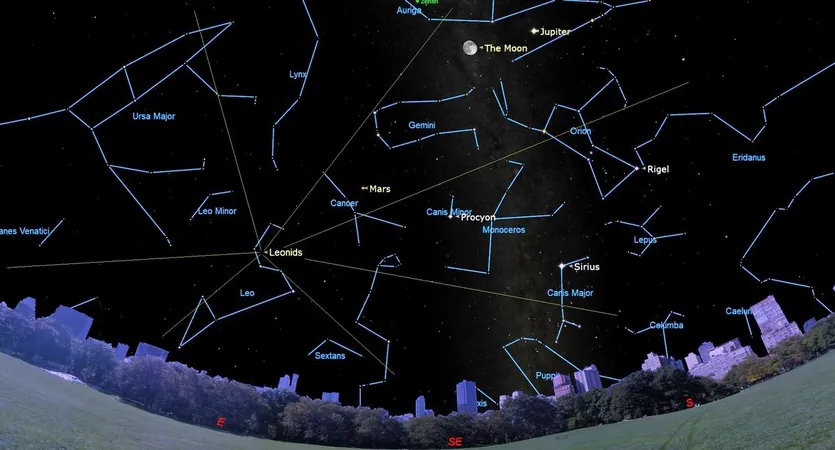
Leonid Meteor Shower Peaks - What to Expect in 2024!
2024-11-17
Author: Ting
As we dive into the heart of the Leonid meteor shower season, it's crucial to set our expectations straight: this year's display might not be as dazzling as many hope. The reality is that without an unexpected surge in activity, the Leonids will be overshadowed by the brightness of a near-full moon on the night of November 15, creating a challenging skywatching environment.
The peak of the Leonid meteor shower occurs on Sunday morning, November 17, when optimal viewing conditions can arise just before dawn. That’s when Leo the Lion rises high in the sky, and the moon will be decreasing in brightness, offering a sliver of hope for those eager to catch some shooting stars.
A Meteor Shower with a Twist
It's important to clarify that the term "meteor shower" can be misleading. While many envision a sky brimming with shooting stars, the reality is often far less dramatic. Historical peaks, such as those in 1833 and 1966, have seen unparalleled meteor activity with thousands of meteors raining down. In recent years—particularly in 1999, 2001, and 2002—the Leonids have shown more moderate displays, with several thousand meteors per hour rather than the extravagant rates of the past.
This year, expectations are tempered. Experts predict a maximum of 10 to 20 meteors per hour, greatly diminished by moonlight. Russian meteorologist Mikhail Maslov has pointed out that nothing extraordinary is anticipated for the 2024 Leonids.
What Causes the Leonids?
The Leonid meteor shower derives its name from Leo the Lion, the constellation where its meteors appear to originate. These meteors are remnants from the Periodic Tempel-Tuttle comet, which travels through our inner solar system approximately every 33 years. Each time it approaches the Sun, it leaves behind a trail of debris, setting the stage for possible meteor storms—if Earth intersects with one of these dust trails.
Tips for the Best Viewing Experience
For those set on observing the Leonids, it's essential to prepare adequately. Find a dark location away from city lights, lie back, and gaze up at the sky. The best time for viewing will be after midnight when Leo becomes fully visible. However, local obstructions like buildings or trees can further hinder your chances, so aim for an open viewing area.
As the meteors collide with Earth's atmosphere at speeds of up to 45 miles per second, they can produce brilliant flashes and extended vapor trails. While the number of spectacular fireballs may be scarce this year, their appearances can be mesmerizing, even in moonlit skies.
While this year's Leonid meteor shower may not live up to the hype, there's still excitement on the horizon. Mark your calendars for the Geminid meteor shower next month, which is anticipated to peak on the night of December 13-14. Prepare yourself with our guide on capturing stunning photos of meteors and keep an eye on our updated night sky guide to maximize your stargazing experience!
Don't Miss Out!
The universe is waiting—get ready to witness one of nature's most breathtaking spectacles, even if the Leonids don’t shine as brightly this year!




 Brasil (PT)
Brasil (PT)
 Canada (EN)
Canada (EN)
 Chile (ES)
Chile (ES)
 España (ES)
España (ES)
 France (FR)
France (FR)
 Hong Kong (EN)
Hong Kong (EN)
 Italia (IT)
Italia (IT)
 日本 (JA)
日本 (JA)
 Magyarország (HU)
Magyarország (HU)
 Norge (NO)
Norge (NO)
 Polska (PL)
Polska (PL)
 Schweiz (DE)
Schweiz (DE)
 Singapore (EN)
Singapore (EN)
 Sverige (SV)
Sverige (SV)
 Suomi (FI)
Suomi (FI)
 Türkiye (TR)
Türkiye (TR)